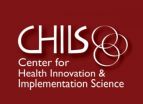(Press-News.org) INDIANAPOLIS -- The new Center for Health Innovation & Implementation Science at the Indiana University School of Medicine and Indiana Clinical and Translational Sciences Institute is studying how best to prepare the future health care workforce as the country's population ages. It calls upon the tools of implementation science to enable these workers and the health systems that will employ them to provide optimal care in a rapidly changing health care environment.
Implementation science, a new discipline, provides tools to clinicians and administrators to deliver better care and better health at lower costs. It does so by equipping them with both theoretical and applied knowledge on how to successfully implement, localize and evaluate evidence-based practice. Implementation science also promotes innovation and invention of new models of care and processes when evidence does not exist.
"Implementation science will allow us to innovate in low-resource environments and provide personalized and population health management," said Malaz Boustani, M.D., MPH, the chief operating officer of the Center for Health Innovation & Implementation Science. "We need a workforce that can provide high-quality, patient-centered and cost-efficient health care in this environment." Dr. Boustani is also chief innovation and implementation officer at Indiana University Health, an IU Center for Aging Research and a Regenstrief Institute scientist, and an IU School of Medicine associate professor of medicine.
In "Preparing the Public Health Workforce with the Tools of Implementation Science,"
a poster presentation, a Center for Health Innovation & Implementation Science team proposes the establishment of research and discovery units within health systems. These units serve as the infrastructure for testing, studying, evaluating and refining strategies to disseminate and implement evidence-based practices that focus on patient outcomes. The team also investigates the impact of dissemination and implementation research when managing a population of patients. The researchers note that using the tools of implementation science, health care professionals and administrators can become part of a new health care workforce that moves evidence into practice and drives innovation on the front lines of health care.
The poster is being presented in Washington, D.C., on May 1 and 2 at the 10th Annual Health Workforce Research Conference, hosted by the Association of American Medical Colleges' Center for Workforce Studies. The theme of this year's conference is "Finding the Right Fit: The Health Workforce Needed to Support the Affordable Care Act."
INFORMATION:
Contributors to the poster are Macey L. Henderson, J.D., and Connor W. Norwood, MHA, doctoral students at the Richard M. Fairbanks School of Public Health at Indiana University-Purdue University Indianapolis; and Nadia Adams, MHA, and Dr. Boustani of the Center for Health Innovation & Implementation Science.
The Center for Health Innovation & Implementation Science uses the tools of implementation science to rapidly translate and implement high-quality, cost-effective health care delivery solutions within local, regional national and international health care systems, striking a balance between the strengths of both academic medicine and corporate health care. Future plans call for the center to offer certificate and master's level training in health innovation and implementation science.
Implementation science can create a workforce equipped for new health care environment
2014-05-01
ELSE PRESS RELEASES FROM THIS DATE:
Hyperfractionated RT improves local-regional control for patients with head and neck cancer
2014-05-01
Fairfax, Va., May 1, 2014—Patients with locally advanced squamous cell carcinoma of the head and neck treated with hyperfractionated radiation therapy (HFX) experienced improved local-regional control and, with patients censored at five years, improved overall survival with no increase in late toxicity, according to a study published in the May 1, 2014 edition of the International Journal of Radiation Oncology ● Biology ● Physics (Red Journal), the official scientific journal of the American Society for Radiation Oncology (ASTRO).
This study, "Final Results ...
Clinical opinion published in American Journal of Obstetrics & Gynecology
2014-05-01
When a woman requires gynecologic surgery, she and her surgeon have several minimally invasive surgical options, including robotic surgery. In recent years, the use of robotic surgery has become more and more common. But questions have arisen about the potential overuse of robotic surgery and its advantages over traditional laparotomy for hysterectomy.
A clinical opinion by Charles Rardin, MD, a urogynecologist in the Division of Urogynecology and Reconstructive Surgery and director of the Robotic Surgery Program for Women at Women & Infants Hospital of Rhode Island, ...
Standard assessments miss early signs of cardiovascular disease in firefighters
2014-05-01
Traditional first-line checks of such heart disease risk factors as cholesterol, blood pressure and smoking habits aren't nearly good enough to identify cardiovascular disease in otherwise healthy, young firefighters, according to results of a small Johns Hopkins study.
Previous studies have found that cardiovascular disease accounts for 45 percent of deaths of on-duty firefighters nationwide, in contrast to 15 percent of deaths among those with conventional occupations, with heart attack being the number one cause of death. The Johns Hopkins researchers designed their ...
Amphibians in a vice: Climate change robs frogs, salamanders of refuge
2014-05-01
By hightailing it to nearby ponds and shallow waterways, frogs and salamanders have – until now – had a way to evade exotic trout introduced to the West's high-mountain lakes for recreational fishing.
A warming climate, however, will dry up some of the places where amphibians and their young have found refuge. Researchers in the May 1 issue of Frontiers in Ecology and the Environment write about this challenge and a novel combination of tools that could help land managers, biologists, fishing enthusiasts and other citizens weigh where amphibians are in the most need of ...
New discovery: Molecule links asthma and cancer and could aid in developing new treatments
2014-05-01
A newly discovered molecule provides a new drug target for controlling both asthma-induced muscle thickening and cancerous tumor growth. This molecule, called "microRNA-10a," normally helps genes produce proteins or make copies of themselves, also play an important role in the growth or overgrowth of human airway smooth muscle cells and some forms of cancer. This newly discovered role, which was published in the May 2014 issue of The FASEB Journal, suggests that manipulating microRNA-10a could lead to new asthma and cancer drugs.
"We hope this study will serve as the ...
Killing Kindlin-3 to cure breast cancer: 'Blood' protein implicated
2014-05-01
A protein believed to be limited to the hematopoietic system, called Kindlin-3, has been identified as a major player in both the formation and spread of breast cancer to other organs. This discovery, published in the May 2014 issue of The FASEB Journal, could open the door to an entirely new class of breast cancer drugs that targets this protein's newly found activity.
"Kill Kindlin-3 to cure cancer," said Elzbieta Pluskota, Ph.D., a researcher involved in the work from the Department of Molecular Cardiology at the Cleveland Clinic Lerner Research Institute in Cleveland, ...
Monitoring, management, and oversight critical for responsible shale gas development
2014-05-01
Ottawa (May 1st, 2014) – A new expert panel report, Environmental Impacts of Shale Gas Extraction in Canada, concludes that shale gas development must be supported by well-targeted science and management strategies to understand and mitigate potential impacts. The report, released today by the Council of Canadian Academies, addresses environmental and associated health impacts and offers insights regarding public engagement and trust.
Shale gas is leading an energy boom which is having profound economic, environmental, and social impacts across much of North America. ...
Rules of thumb: 3 simple ideas for overcoming childhood obesity
2014-05-01
New Orleans, LA – Kristopher Kaliebe, MD, Clinical Assistant Professor of Psychiatry at the LSU Health Sciences Center New Orleans School of Medicine, offers parents and caregivers three simple family-oriented goals to overcome the complex problem of childhood obesity and related mental disorders. They involve limit setting to address the brain's "get more" drive strengthened through habitual over-consumption of temptations including highly caloric processed food, hyper-reality media and electronics, as well as excessive sitting. His 3 "rules" of living promote physical ...
Individual brain activity predicts tendency to succumb to daily temptations
2014-05-01
Activity in areas of the brain related to reward and self-control may offer neural markers that predict whether people are likely to resist or give in to temptations, like food, in daily life, according to research in Psychological Science, a journal of the Association for Psychological Science.
"Most people have difficulty resisting temptation at least occasionally, even if what tempts them differs," say psychological scientists Rich Lopez and Todd Heatherton of Dartmouth College, authors on the study. "The overarching motivation of our work is to understand why some ...
Antimicrobial edible films inhibit pathogens in meat
2014-05-01
Antimicrobial agents incorporated into edible films applied to foods to seal in flavor, freshness and color can improve the microbiological safety of meats, according to researchers in Penn State's College of Agricultural Sciences.
Using films made of pullulan -- an edible, mostly tasteless, transparent polymer produced by the fungus Aureobasidium pulluns -- researchers evaluated the effectiveness of films containing essential oils derived from rosemary, oregano and nanoparticles against foodborne pathogens associated with meat and poultry.
The results demonstrate that ...


